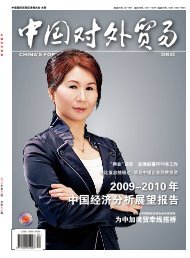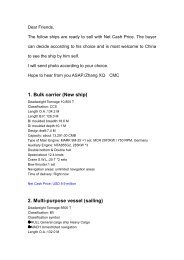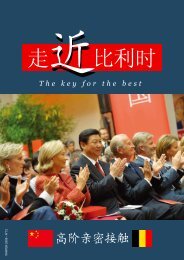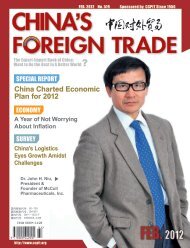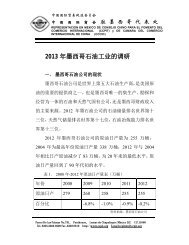Industrial WatchIndustrial WatchThe first Sino-US Innovation andEntrepreneurship Summit of Carnegie MellonUniversity held in PittsburghJointly organized By Sino-US Innovation and EntrepreneurshipSummit Organizing Committee of CarnegieMellon University (CMU), the Chinese Studentsand Scholars Association (CMU-CSSA), and HuayuanScience and Technology Association (HYSTA), the firstSino-US Innovation and Entrepreneurship Summit ofCarnegie Mellon University was held on April 28-29 inCarnegie Mellon University, Pittsburgh, Pennsylvaniastate of the United States. A great number of talents of scienceand business from both China and the United Statesattended the summit, exchanged in-depth ideas on Sino-US innovation in such fields as information technology,new energy, health care industry, and financial industry,as well as gave valuable suggestions on how to stimulateentrepreneurial enthusiasm of Chinese students studyingin the United States and guide them to make better useof their own advantages in improving the success rate ofentrepreneurship.This summit was sponsored by well-known enterprisessuch as Sinopec, and Verizon, and got muchsupport from Mr. Kai-fu Lee, a famous alumni and thecurrent CEO of the Innovation Works and Mr. Xu Xiaoping,the founder of Zhen Fund and co-founder of NewOriental. In addition, many leading figures in such fieldsas IT, finance, medicine, biotechnology, energy & environment,and entrepreneurship & investment participatedin this summit, including Mr. Huang Shu, a ManagingPartner of Yuandu Investment and Consulting Inc., Mr.Song Anlan, China Managing Partner of Softbank, Mr.Jiang Xiaodong, China Managing Director of NEA, andCharles Kennedy, Chief Investment Officer of CarnegieMellon University. Six sub-forums was set up in the summit,and more than 30 industry elites will discuss with theaudience on the following topics respectively: informationand digital entertainment technology, cloud computingand security technologies, energy and environment, financialand capital markets, medical and biotechnology, andinnovation and entrepreneurship.Ma Rui, founder and Chairman of the summitholds that the mission of this summit is to make institutionsfrom both China and United States get together viaCMU, the leading global education platform, in a viewto enhancing better mutual understanding, creating po-tential business opportunities, boosting pragmatic Sino-US cooperation, promoting the popularity of CMU andPittsburgh in China as well as improving their regionalinfluences.Chairman Ma tells reporters that in the past few decades,China has successfully transformed into the focusof global political and economic development. The rapideconomic growth has made China the world's secondlargest economy only second to the United States, andat the same time established China’s important positionin international relations. Rapidly growing middle class,well-educated graduates, as well as the world’s leadinginnovative companies indicate that China will usher ina better future. Although the U.S. economy has beengreatly affected by the financial crisis in recent years, theUnited States remains a major driving force in the globaleconomy. Therefore, it has become a common understandingthat sound Sino-US cooperation will benefit theglobal economic growth.At last, he indicates that depending the mutualunderstanding between China and the United States willfurther promote bilateral cooperation, which helps toproduce a comprehensive solution for problems and challengesfacing both countries. Therefore, the high-profilesummit becomes an excellent platform for bilateral exchanges,as it brings together famous entrepreneurs, corporateexecutives, venture capitalists, and researchers fromboth countries to discuss and resolve major economic andtechnological issues, and seek for new partnerships. Tothis end, the Carnegie Mellon Summit and the China-USInnovation and Entrepreneurship Forum came into being.Carnegie Mellon University was established in 1900by Andrew Carnegie. Andrew Carnegie also producedCMU’s school motto “My Heart is in the Work” whichenjoys popular favor and has become a firm belief of thestudents and teachers in the pursuit of truth. Meanwhile,innovation and entrepreneurship is an eternal hot topic onCMU campus.Pittsburgh was praised by U.S. President BarackObama as the model for economic development in the21st century. After the successful G20 summit in 2009,Pittsburgh has drawn more and more attention. And now,Pittsburgh is ready to bridge China-US exchanges.32
Regional Trade & InvestmentNORTH AMERICA2012By Lesley CuiState of AmericanBusiness in ChinaAmid rising costs and moderating economicgrowth, there is increasing urgency for Chinato enact market reforms in order to transitionto a more innovative and sustainableeconomic model, according to the 2012 State of AmericanBusiness in China White Paper released by theAmerican Chamber of Commerce in China (AmChamChina).The annual White Paper, now in its 14th edition,is written by representatives from over 1,200 membercompanies of AmCham China. It outlines key developmentsand challenges across a wide range of industriesin which US member companies operate in China, fromagriculture to financial services to retail. It also containssuggestions for both the US and Chinese governmenton how to improve the business climate.As China’s economy grows, market conditions remaingood for business, and AmCham China membersreport strong revenues and good profit margins. Am-Cham China members remain strongly committed tobusiness growth and participation in the China market.However, the 2012 White Paper identifies growinguncertainties over the future pace and directionof economic reform and the impact on operations inChina.China’s progress toward a market economy hasslowed in recent years and the outcome of ongoingefforts to rebalance the economy to create a marketbased on domestic demand and sustainable innovationremains uncertain. “AmCham China commends thegovernment for the many successes it has achieved, butthe transition to a new economic growth model presentsnew challenges. A new commitment to deepen marketreforms and extend a truly market economy to additionalsectors of the economy will ensure more sustainableeconomic growth in the future and create new opportunitiesfor companies and consumers,” said AmChamChina Chairman Ted Dean.As China enters a transition phase in its economicdevelopment, the 2012 White Paper outlines policy recommendationsthat will benefit China’s economy andadvance China’s development goals. “To position itselffor the coming decades of growth, we believe Chinashould promote more vibrant competition. It coulddo so by opening up market access across the manyindustries that remain restricted to foreign investors,completing the transition to a market economy, andpromoting greater consistency and transparency in governmentpolicies around the country,” said Ted Dean.Specific policy recommendations in the 2012White Paper for improving the business and investmentenvironment include a focus on human resource challenges,improving regulatory coherence across China, increasinglicensing opportunities for member companiesand improving intellectual property rights protection.Rising labor costsEighty nine percent of member companies believeChina is losing its competitive advantage due to risingcosts, up 11 percent from last year. 82 percent of respondentssaid the cost of social benefits would hurt theiroperations, compared to 53 percent a year ago.Management-level human resources are seen as theleading business challenge and nonmanagement-levelconstraints rank third, while other inputs such as thecost of land, rent, raw materials and transportation arealso rising. China is losing its competitiveness in laborcosts and that will eventually lead to a structural changein manufacturing and trade, but it is also a positiveoutcome of ongoing efforts to rebalance the economy,AmCham China said.Strong commitment of US companies to the Chinesemarket is subject to China’s future policy choicesand development path, as well as external risks such asanother global economic slowdown, according to TedDean, chairman for AmCham China.Stronger competition from ChineseenterprisesThe growing strength of Chinese companies -both State-owned and in the private sector - has beenhighlighted in the report. 68 percent of respondentssaid they had faced increased competition from Chinesefirms, with a third saying that this competition had“increased greatly”. The period measured was between2011 and 2010.60









